 |
 |
Figure 50-46
A and B,
Signal systems involved in positive inotropic and lusitropic (enhanced relaxation)
effects of β-adrenergic stimulation. When the β-adrenergic agonist interacts
with the β-receptor, a series of G protein-mediated changes lead to activation
of adenylate cyclase and the formation of cyclic adenosine monophosphate (cAMP).
The latter acts via protein kinase A to stimulate metabolism (left)
and phosphorylate the calcium channel protein. The result is an enhanced probability
of the calcium channel being open, thereby increasing the inward movement of Ca2+
ions through the sarcolemma (SL) of the T tubule. These Ca2+
ions release
more calcium from the sarcoplasmic reticulum (SR) to increase cytosolic calcium and
activate troponin C. Calcium ions also increase the rate of breakdown of adenosine
triphosphate (ATP) to adenosine diphosphate (ADP) and inorganic phosphate (Pi
).
Enhanced myosin ATPase activity explains the increased rate of contraction, with
increased activation of troponin C explaining the development of increased peak force.
An increased rate of relaxation is explained by the fact that cAMP also activates
the protein phospholamban (PL), which is situated on the membrane of the SR and controls
the rate of uptake of calcium into the SR. The latter effect explains enhanced relaxation
(lusitropic effect). TnI, troponin I. (From Opie LG: Receptors and signal
transduction. In Opie LH [ed]: The Heart, Physiology
from Cell to Circulation, 4th ed. Philadelphia, Lippincott Raven, 1997, pp 173–207.)

 |
